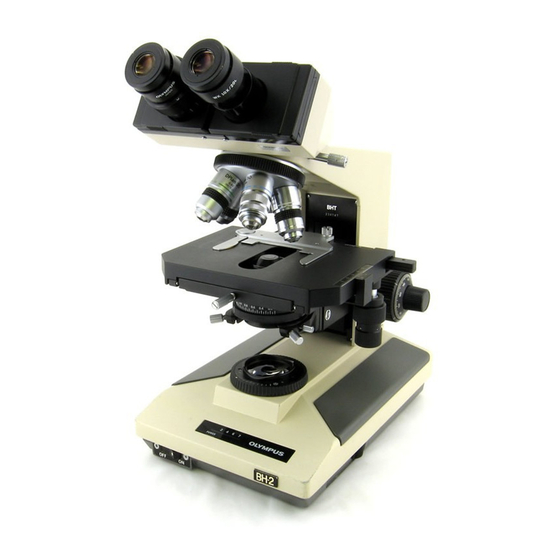- ページ 3
顕微鏡 Olympus BH-2 BHTのPDF マニュアルをオンラインで閲覧またはダウンロードできます。Olympus BH-2 BHT 24 ページ。 Sliding focus block
Olympus BH-2 BHT にも: 完全な分解、洗浄、再組み立て (23 ページ)

Electrical power from the AC line is applied to the equipment via the AC line cord, which plugs into J101 on the back of
the microscope base. Power transformer T101 converts the AC line voltage (120V or 240V, depending on which
transformer is installed) to approximately 9V RMS on the secondary winding. The output of the secondary winding
feeds into bridge rectifier DB101, whose full‐wave‐rectified output in turn feeds the lamp dimmer circuitry. Bridge
rectifier DB101 is necessary to provide DC to the lamp dimmer circuitry, since transistors Q101 and Q201 in the dimmer
circuit are bipolar junction devices which can conduct current in only a single direction.
Potentiometer RV101 controls the lamp intensity. When RV101 is adjusted for minimum intensity (i.e., the wiper is at
the top end of its travel), the full output voltage of bridge rectifier DB101 is fed to the base of transistor Q201 via
resistor R202. Under this condition, transistor Q201 will not conduct since the base‐emitter junction is not forward
biased and there will be no collector current in Q201, and therefore no base current in transistor Q101. Without base
current, transistor Q101 will be cutoff and no current will flow through the lamp.
As potentiometer RV101 is moved from its minimum intensity position in the direction of increasing intensity (i.e., the
wiper is moved towards the zero reference ground), the control signal feeding the base of transistor Q201 decreases,
progressively forward biasing its base‐emitter junction and allowing it to increasingly conduct collector current. Since
the collector current of transistor Q201 is the base current of transistor Q101, Q101 in turn begins to conduct increasing
amounts of collector current, which flows through the halogen lamp. The lower the amplitude of the control signal from
the potentiometer, the higher the resulting lamp current and corresponding lamp intensity.
The overall DC current gain of the lamp dimmer is considerable, and is approximately equal to the product of the
individual β values of transistors Q201 and Q101 (i.e., β
~ β
x β
). Because of this high value for β
, the
OVERALL
Q201
Q101
OVERALL
halogen lamp will be fully illuminated with little base current in transistor Q201, thereby introducing only a minimal
voltage drop across resistor R202. Neglecting this minimal drop, the voltage present on the bottom terminal of the lamp
is approximately 0.7V higher than the control signal from the potentiometer, at any setting of the potentiometer
(excluding the minimum‐intensity setting, where there is no forward bias on the base‐emitter junction of transistor
Q201). This means that the lamp voltage may be adjusted from zero at one extreme of the intensity control to nearly
the full output voltage of DB101 at the other extreme of the intensity control.
Figure 2 is the lamp dimmer circuitry shown in Figure 1 with the addition of transistor Q202, resistor R201, and capacitor
C202. These three components provide a current‐limiting function for the dimmer, to prevent damage to the lamp in
the event of power surges on the AC line and to minimize thermal stresses on the lamp at power‐up.
Figure 2 – BHT/BHTU Lamp Dimmer Circuitry (with Current Limiting)
Olympus BH‐2 (BHT/BHTU) Electronics
Revision 2
Page 3 of 24
